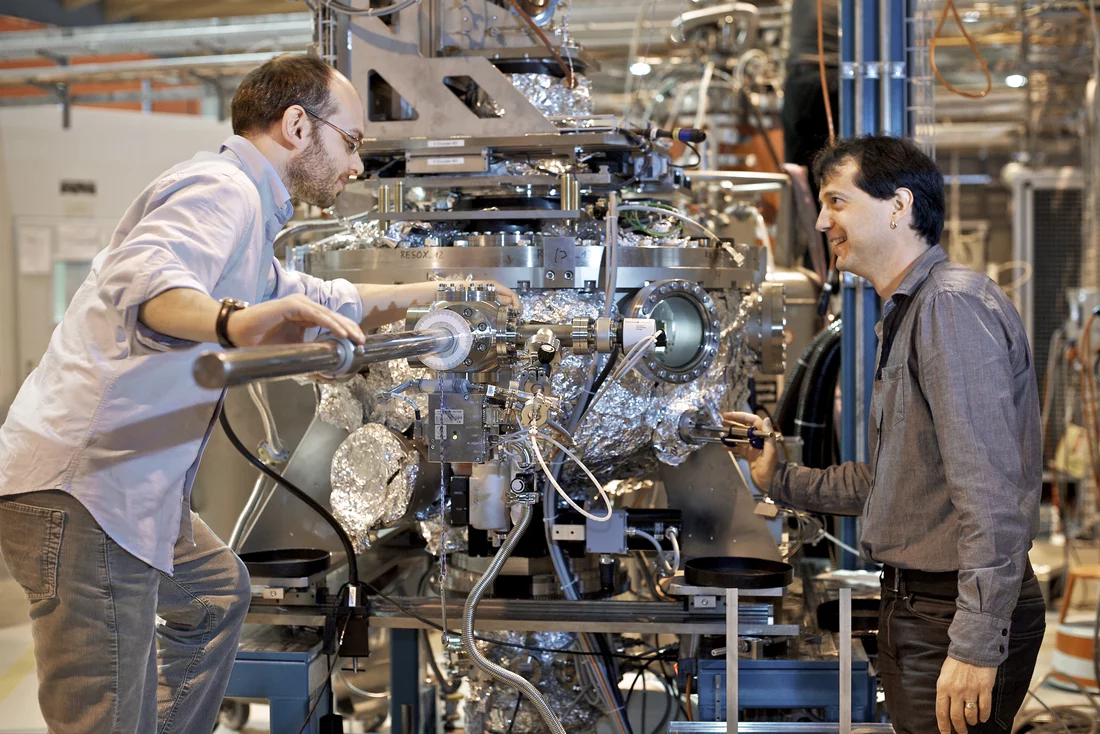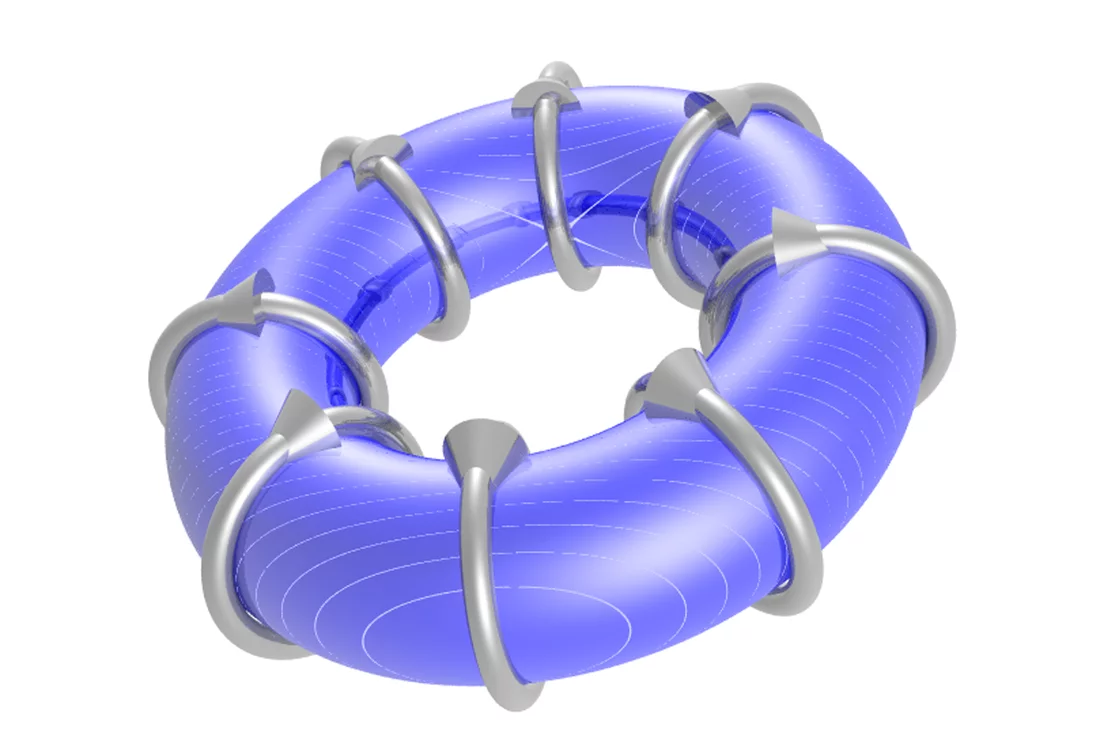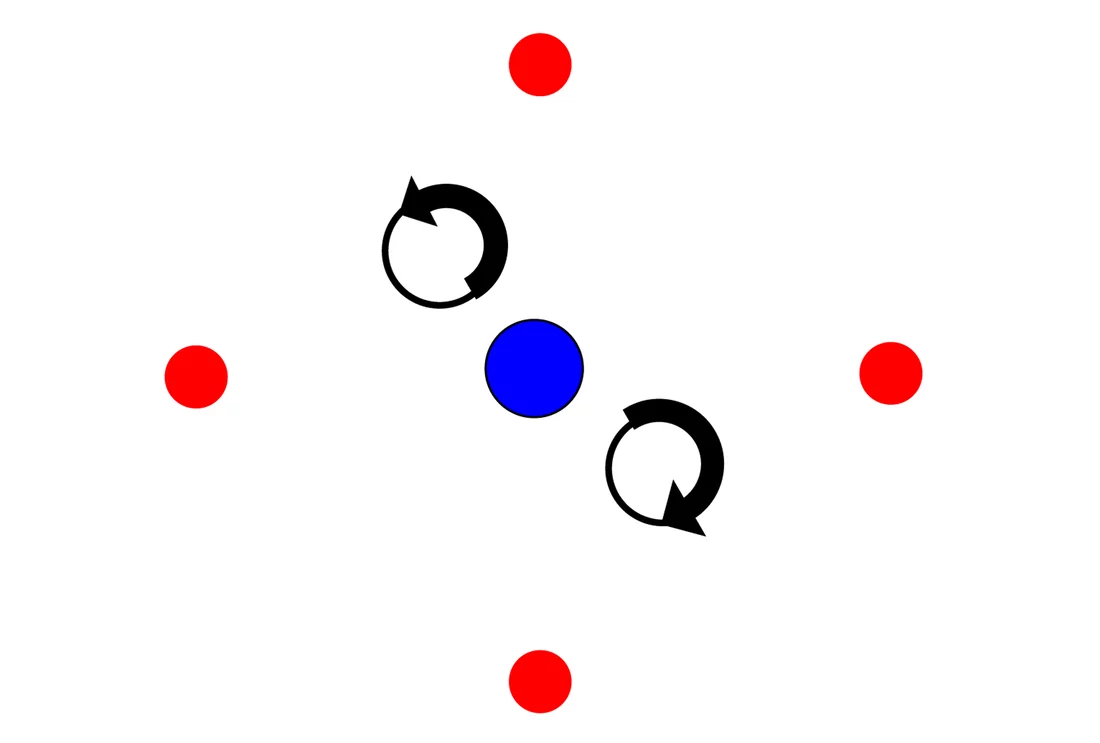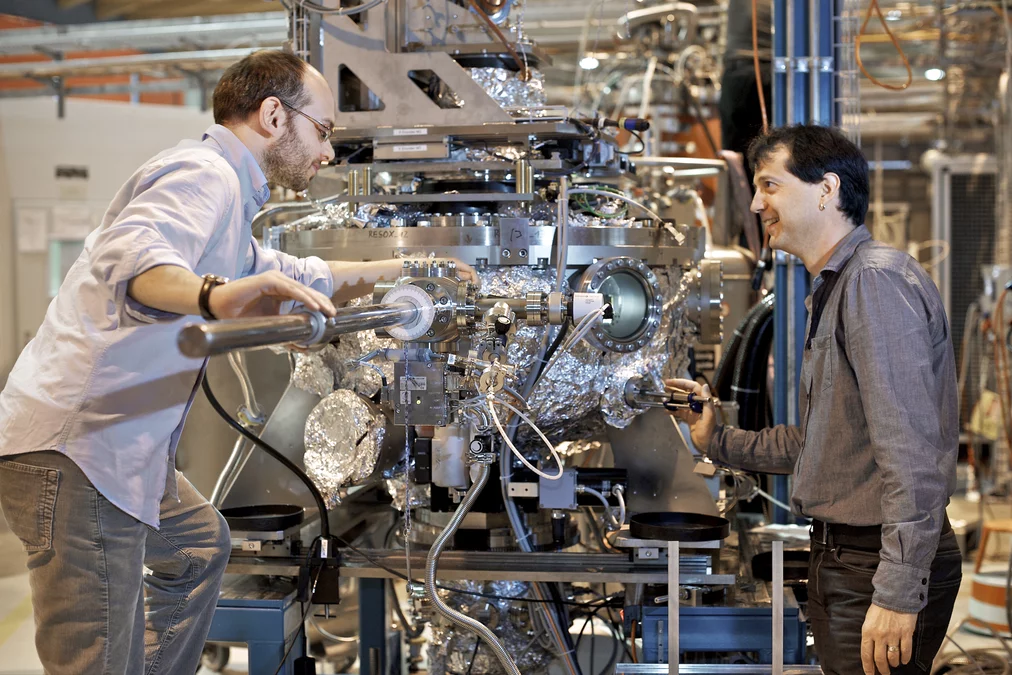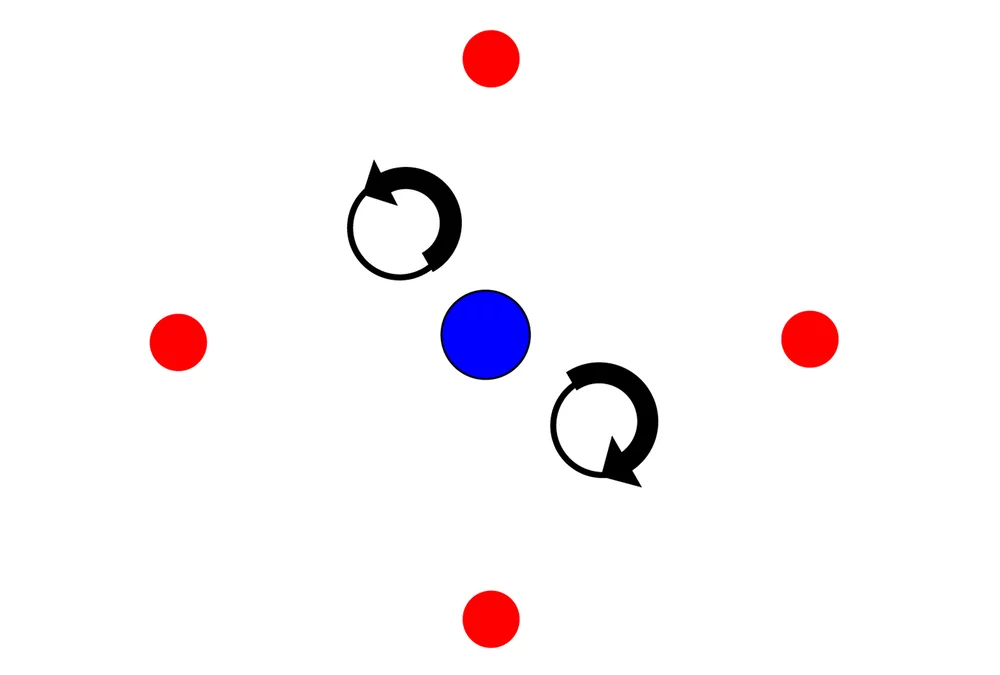Paul Scherrer Institute researchers prove, for the first time, the existence of toroidal currents in solids
Paul Scherrer Institute researchers have, for the first time, observed a novel kind of object that can exist in materials with unusual electrical and magnetic properties. This object corresponds to a particular type of electron current, with the electron cloud having the form of a torus and the electrons flowing along the meridians of the torus. This toroidal current differs from normally observed electron orbitals in the basically different symmetry which links the magnetic and electrical properties. Now that the fundamental existence of toroidal currents in solid materials has been proven, researchers expect that they will find them in other materials, too. Thus these currents may be able to explain the behaviour of high-temperature superconductors – materials that have no electrical resistance at relatively high temperatures. The necessary measurements have been taken at the Swiss Light Source (SLS) at the Paul Scherrer Institute, where the polarised synchrotron light that is required for this experiment is available. The research results have appeared in the online version of the scientific journal Science.
Paul Scherrer Institute researchers have, for the first time, observed a novel kind of object that can exist in materials with unusual electrical and magnetic properties. This object corresponds to a particular type of electron current, with the electron cloud having the form of a torus and the electrons flowing along the meridians of the torus. This toroidal current differs from normally observed electron orbitals in the basically different symmetry which links the magnetic and electrical properties. Now that the fundamental existence of toroidal currents in solid materials has been proven, researchers expect that they will find them in other materials, too. Thus these currents may be able to explain the behaviour of high-temperature superconductors – materials that have no electrical resistance at relatively high temperatures. The necessary measurements have been taken at the Swiss Light Source (SLS) at the Paul Scherrer Institute, where the polarised synchrotron light that is required for this experiment is available. The research results have appeared in the online version of the scientific journal Science.
High-temperature superconductivity still belongs to the great unexplained phenomena of modern physics. High-temperature superconductors are complex ceramic materials which, below the so-called critical temperature, have no resistance to electrical current. Researchers at the Paul Scherrer Institute in Switzerland have now been able to take a possibly important step towards understanding these materials. For this, they have investigated copper oxide (CuO) as a model – a simpler material, but one which has, in copper and oxygen, the same constituents as many high-temperature superconductors and shares the same fundamental building block: the copper and oxygen atoms are here regularly ordered in plaquettes, where each plaquette consists of one copper atom surrounded by four oxygen atoms.
Electron flow on the torus
In this material, the researchers were the first to be able to observe a so-called toroidal current, in which the electron cloud takes on the form of a torus – better known, for instance, as the form of a doughnut. This can be imagined in some way as the electron flow taking place on the surface of the torus, along the meridian lines. What is special about such an object are its symmetry properties, which differ significantly from the other forms of electron current in solid materials. Such symmetry properties can be classified according to how the object changes when either the spatial coordinate system is inverted or the direction in which time is passing changes. “Magnetic objects change their direction when one reverses time, but not when one mirrors the space dimensions. Electrical ones, however, reverse their direction when the space dimensions are mirrored, but remain the same when time is reversed. The object that we have detected changes its direction in the case of both transformations and reverts to its original state when both transformations are applied one after the other. The object therefore unites magnetic and electrical properties,” declares Urs Staub, one of the PSI researchers involved. Such objects have long been known from nuclear physics, as well as from the macroscopic world: one can picture this as when a magnetic coil is simply bent to form a ring, in order to create such an object.
Understanding the properties of high-temperature superconductors
These special symmetry properties mean that such toroidal currents might also appear in so-called pseudogap phases and could explain their origins. This unusual material state occurs in many high-temperature superconductors, above the critical temperature. Numerous theories have been developed to explain the pseudogap phase, as many scientists expect that an understanding of the pseudogap phase will reveal how the associated superconducting state arises. “The material that we have investigated is not a superconductor and therefore has no associated pseudogap phase. We have, however, demonstrated that toroidal currents can really exist in materials. This is evidence that theories which explain the properties of superconducting materials with the presence of such states could be pointing in the right direction,” emphasises Valerio Scagnoli, who led the project at PSI. “And an experiment in which such a toroidal current in the pseudogap phase could be observed would possibly also help to decide which theory describes this phase.”
The researchers performed their experiment at the Swiss Light Source (SLS) at the Paul Scherrer Institute. Here, with the help of polarised synchrotron light, they carried out scattering experiments on the material being investigated. They were able to reveal the properties of the object under investigation by observing how the polarisation of the beam changed during the scattering process. “The scattering showed both the magnetic and electrical contributions, which could be explained only by the presence of toroidal currents,” according to Staub.
Text: Paul Piwnicki
Electron flow on the torus
In this material, the researchers were the first to be able to observe a so-called toroidal current, in which the electron cloud takes on the form of a torus – better known, for instance, as the form of a doughnut. This can be imagined in some way as the electron flow taking place on the surface of the torus, along the meridian lines. What is special about such an object are its symmetry properties, which differ significantly from the other forms of electron current in solid materials. Such symmetry properties can be classified according to how the object changes when either the spatial coordinate system is inverted or the direction in which time is passing changes. “Magnetic objects change their direction when one reverses time, but not when one mirrors the space dimensions. Electrical ones, however, reverse their direction when the space dimensions are mirrored, but remain the same when time is reversed. The object that we have detected changes its direction in the case of both transformations and reverts to its original state when both transformations are applied one after the other. The object therefore unites magnetic and electrical properties,” declares Urs Staub, one of the PSI researchers involved. Such objects have long been known from nuclear physics, as well as from the macroscopic world: one can picture this as when a magnetic coil is simply bent to form a ring, in order to create such an object.
Understanding the properties of high-temperature superconductors
These special symmetry properties mean that such toroidal currents might also appear in so-called pseudogap phases and could explain their origins. This unusual material state occurs in many high-temperature superconductors, above the critical temperature. Numerous theories have been developed to explain the pseudogap phase, as many scientists expect that an understanding of the pseudogap phase will reveal how the associated superconducting state arises. “The material that we have investigated is not a superconductor and therefore has no associated pseudogap phase. We have, however, demonstrated that toroidal currents can really exist in materials. This is evidence that theories which explain the properties of superconducting materials with the presence of such states could be pointing in the right direction,” emphasises Valerio Scagnoli, who led the project at PSI. “And an experiment in which such a toroidal current in the pseudogap phase could be observed would possibly also help to decide which theory describes this phase.”
The researchers performed their experiment at the Swiss Light Source (SLS) at the Paul Scherrer Institute. Here, with the help of polarised synchrotron light, they carried out scattering experiments on the material being investigated. They were able to reveal the properties of the object under investigation by observing how the polarisation of the beam changed during the scattering process. “The scattering showed both the magnetic and electrical contributions, which could be explained only by the presence of toroidal currents,” according to Staub.
Text: Paul Piwnicki
About PSI
The Paul Scherrer Institute develops, builds and operates large-scale, complex research facilities, and makes these facilities available to the national and international research community. The Institute”s own research focuses on solid-state physics and the materials sciences, elementary particle physics, biology and medicine, as well as research involving energy and the environment. With a workforce of 1400 and an annual budget of about 300 million CHF, PSI is the largest research institution in Switzerland.Contact
Dr. Valerio Scagnoli, Laboratory for Condensed Matter, Synchrotron Radiation and Nanotechnology Research Division,Paul Scherrer Institute, 5232 Villigen PSI, Switzerland
Tel: +41 56 310 5366, E-Mail: valerio.scagnoli@psi.ch [English, Italian]
Dr. Urs Staub, Laboratory for Condensed Matter, Synchrotron Radiation and Nanotechnology Research Division,
Paul Scherrer Institute, 5232 Villigen PSI, Switzerland
Tel: +41 56 310 4494, E-Mail: urs.staub@psi.ch [German, English]
Original Publication
Observation of Orbital Currents in CuO V. Scagnoli, U. Staub, Y. Bodenthin, R. A. de Souza, M. García-Fernández, M. Garganourakis, A. T. Boothroyd, D. Prabhakaran, S. W. Lovesey Science Express, 7 April 2011;DOI: 10.1126/science.1201061
Images
Click on the disc icon to download the high resolution version.
